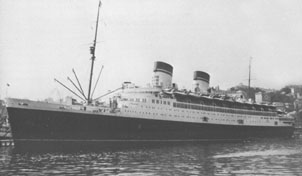SS Conte di Savoia
| |
This article needs additional citations for verification. Please help improve this article by adding reliable references. Unsourced material may be challenged and removed. (May 2008) |
| 50x40px | This article includes a list of references, related reading or external links, but its sources remain unclear because it lacks inline citations. Please improve this article by introducing more precise citations where appropriate. (April 2009) |
 SS Conte di Savoia lying at anchor at Genoa | |
| Career | |
|---|---|
| Name: | SS Conte di Savoia |
| Owner: | Italian Line |
| Port of registry: | Flag of Italy Italy |
| Builder: | Cantieri Riuniti del'Adriatico of Trieste, Italy |
| Launched: | October 1931 |
| Maiden voyage: | November 1932 |
| Fate: | Scuttled by retreating German military in September 1943 and scrapped in 1945. |
| General characteristics | |
| Type: | Ocean liner |
| Tonnage: | 48,502 gross tons |
| Length: | 814 ft (248.1 m) |
| Beam: | 96 ft (29.3 m) |
| Installed power: | Steam turbines |
| Propulsion: | Quadruple propellers |
| Speed: | 27 knots (50 km/h) |
| Capacity: |
2,200 total:
|
| Crew: | 786 total |
SS Conte di Savoia (Count of Savoy) was an Italian ocean liner built in 1932 at Cantieri Riuniti del'Adriatico, Trieste.
Conte di Savoia was originally ordered for the Lloyd Sabaudo line, however a merger with the Navigazione Generale Italiana saw the ship completed for the newly formed Italia Flotte Riunite. The new Italia Line also controlled the Rex, a similar though slightly larger ship completed just two months before Conte di Savoia. The Conte di Savoia was more modern in decoration and appearance than the Rex and was considered to be an exceptionally beautiful ship.
History
In November 1932 she made her maiden voyage to New York. The voyage almost became a disaster when an outlet valve jammed and blew a large hole below the waterline. The ship completed her maiden voyage thanks to crew member Gennaro Amatruda who plugged a leak in a broken valve-port saving the ship from possible disaster. The Conte di Savoia never held the Blue Riband for fastest Atlantic crossing, although on one attempt she did average just 0.2 knots (0.4 km/h) slower than the Blue Riband holder Rex.
Conte di Savoia had one unusual feature designed to increase passenger numbers. Three huge gyroscopes were fitted low down in a forward hold. These rotated at high revolutions and were designed to eliminate rolling - a persistent problem on the rough North Atlantic crossing that affected all shipping lines. In practice they reduced the rolling by slowing down the rolling period, however, they also caused the vessel to 'hang' annoyingly when the vessel was on the extreme limit of her rolls. For obvious safety reasons the system was quickly abandoned on eastbound crossings where the prevailing weather produced following seas, although it was still used on westbound crossings. Of course, none of this ever affected the operation of the shipping lines advertising department and the benefits of a "smooth crossing" were heavily promoted during the life of the ship.
During troop service in World War II, Conte di Savoia was set on fire and scuttled by retreating German forces on 11 September 1943. She was re-floated in 1945, but eventually was scrapped.
See also
References
- http://www.20thcenturyliners.com/il_contds.htm
- http://www.oceanlinermuseum.co.uk/Conte%20di%20Savoia.html
- History
- Statistics
de:Conte di Savoia es:SS Conte di Savoia it:Conte di Savoia (transatlantico) pl:SS Conte di Savoia pt:Conte di Savoia
- Articles needing additional references from May 2008
- Articles with invalid date parameter in template
- All articles needing additional references
- Pages with broken file links
- Articles lacking in-text citations from April 2009
- All articles lacking in-text citations
- Ocean liners
- Passenger ships of Italy
- Steamships of Italy
- Troop ships of Italy
- 1931 ships
